Oil paints for wooden facades. Exterior wood paint for exterior use
All owners of wooden houses immediately think about how to protect their future homes from harmful influences environment. Modern technologies and achievements make it possible not only to protect, but also to transform the appearance of the house. Exterior wood paint is perfect for this.
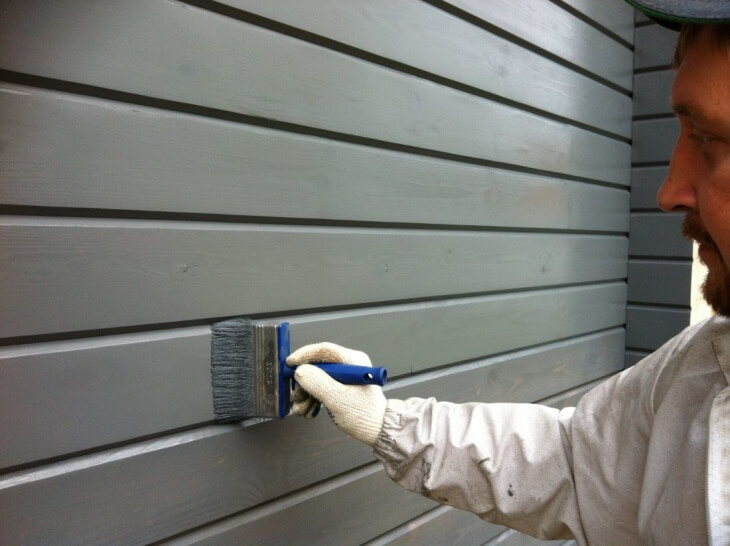
Literally ten years ago, all their “protection” consisted in the fact that they enveloped the tree with a film that prevented the penetration of both moisture and air, and sunlight. It was opaque paint. Moreover, the number of colors and shades offered on the market did not exceed one hundred. Now everything has changed dramatically.
Basic properties of paint
In fact, the main function that manufacturers include in paints is protective. They also think about the decorative component, but it is not a priority. The paint should protect the wood from the following negative factors:
- Ultraviolet. This type of solar radiation has an extremely detrimental effect on appearance wood, causing it to fade and lose its visual appeal;
- Rain. When exposed to moisture, wood swells and shrinks when it dries. As a result, cracks appear on the wood, which not only look unsightly, but also significantly reduce the strength of the solid;
- Insect pests. A variety of beetles and worms can turn even a beam with a cross-section of 10x10 cm into a sieve in 5-10 years. Naturally, after a couple of years of their “work” the tree will lose most its strength.
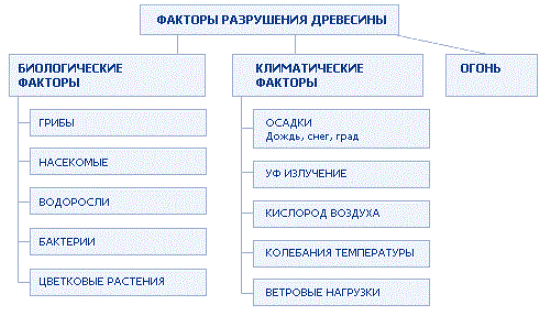
Types of paints for a wooden house
Today there is a whole host of colors available. And on each of the cans it says something different. In order not to get lost among all this diversity, you need to know what types of paints stand out among others:
- Antiseptic. A protective coating that prevents the appearance of various bacteria and fungi on the surface of the wooden parts of the house. There are 2 types of antiseptics: covering - this is paint that envelops the tree, hiding its structure underneath; glazing – a varnish that saturates solid wood with antiseptic substances, but does not hide the natural grain of the wood;
- Acrylic coating. This is for everyone known remedy which is popular recent years 5-7 and not giving up their positions. This is facilitated by the environmental friendliness of the coating, its durability, the absence of unpleasant odors, ease of application during work and quick drying;
- Oil coating. Here it is worth noting the fact that, as opposed to acrylic, it can provide excellent impregnation instead of enveloping in its acrylic counterpart. Thanks to this, all the positive effects that the chemists of the manufacturing company added to it are absorbed into the wood and do not remain on its surface. The following advantages can also be attributed to this: reasonable price, huge selection of colors and shades, the ability to simply update the coating by applying a new layer on top of the old one, and also respond well to temperature changes. The only drawback to acrylic paints for the house is for a long time drying, and even acquiring a matte texture over time, but this cannot be called a disadvantage;
- Alkyd paint. This is a representative of the old school, who does not give up his positions today. Its main feature is its rapid drying after painting. Thanks to this, residents of the house can move into it within 12 hours after applying the coating. But such a short drying time is also a disadvantage, since the coating layer does not have time to be deeply absorbed into the wood;
- Rubber paint. Has the best protective properties. It simply envelops the tree, not allowing any external influences. In terms of its characteristics, it is very similar to acrylic coatings, but has a slightly more modern composition.
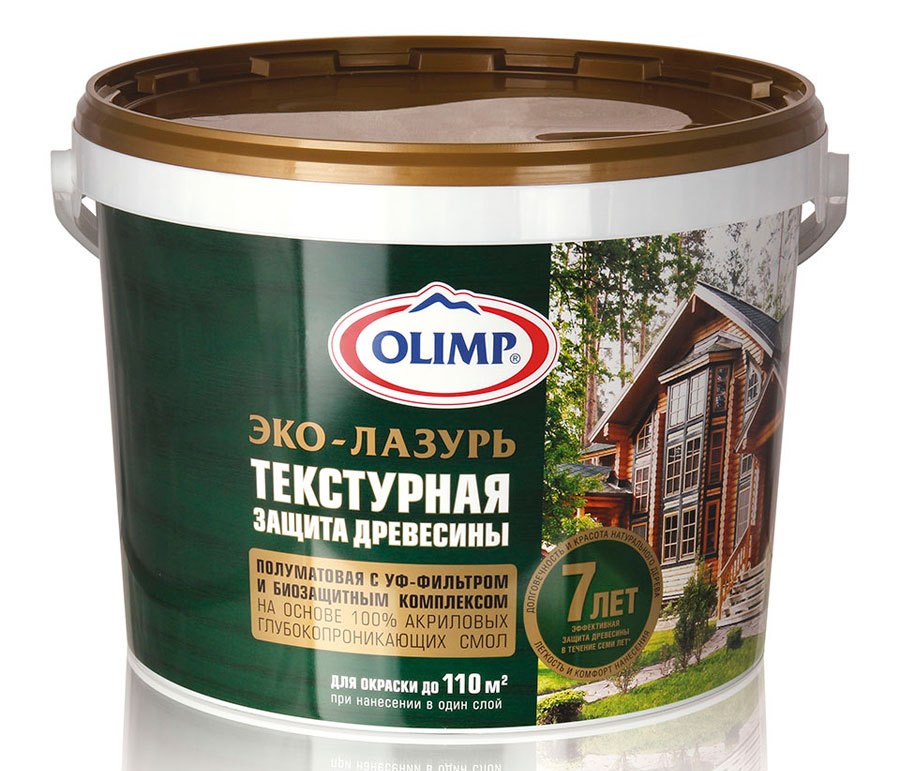
Water-dispersion paint. This is the latest baby modern science. Due to the absence of any chemically harmful compounds that are present in other coatings, it is absolutely safe for health. In fact, water-dispersion paints are whole line various coatings for a wooden house. They include acrylic compounds, rubber and alkyd.
All that distinguishes water-dispersion coatings from traditional ones is their environmental friendliness and the absence of hazardous chemical compounds.
Preparatory work with wood before painting
Before applying any paint to wood, it needs to be prepared. At the beginning of work, the array is cleaned of burrs, dirt and old coating. A sanding machine is perfect for this. If the tree is new, then all chipped parts on it are smoothed out and chipped chips are removed. If the wood is not new, then the sanding machine removes the top layer of the wood, thereby giving it a fresh look.
![]()
The second step is chemical treatment. Now comes the turn of applying the primer. It is advisable not to neglect this coating. The fact is that primers have an antiseptic effect and promote better bonding of paint to wood. On average, the service life of a color coating applied to a primer is 5-10 times longer than when applied simply to wood. In addition, the possibility of various infections appearing on the boards is also prevented.
How to paint the facade of a wooden house
There are several fundamental rules in the painting process that apply to all types of paints:
- Painting should be carried out at ambient temperatures from +5°C to 20°C;
- The surface of the wood must be dry during work;
- Facade paint should only be used for application to the facade of the house. It is strictly forbidden to use it indoors;
- The paint is applied in several layers. The first layer is absorbed into the wood, so it changes color after drying. The same advice applies to varnishes. The first layer is absorbed. All subsequent ones will already serve as a protective film;
- The primer and impregnation must be made by the same manufacturer as the main paint coating.
Conclusion
Today's choice of facade paints for wood is truly huge. And it’s really difficult to stop at just one. And, if you are offered to take several paints and try to paint small samples of wood with them in order to see how they will look, then you should not do this. It is important to remember: the coating that looks beautiful on the board can become gray and unremarkable when applying paint to the entire wall.
Ultimately, choosing a specific paint or varnish is necessary from natural conditions, in which the house is located, personal desires and, of course, possibilities. But best choice Water-dispersed paints will be used, since they show the best results in terms of service life and are completely environmentally friendly building materials.
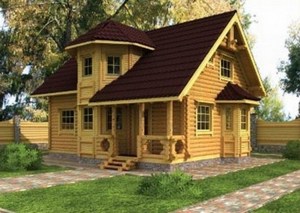 It is necessary to care for and protect them from various influences. One of the means of such protection is modern façade paint on wood, which also serves as a decoration. Not only the quality of the paint itself determines the durability and integrity of the painted surface. It is important to follow the technology of application and preparation for painting. All this will be discussed in this article.
It is necessary to care for and protect them from various influences. One of the means of such protection is modern façade paint on wood, which also serves as a decoration. Not only the quality of the paint itself determines the durability and integrity of the painted surface. It is important to follow the technology of application and preparation for painting. All this will be discussed in this article.
Why paint wood
Wood is one of the most vulnerable to environmental influences building material. That's why she needs additional protection from the following harmful factors:
- excess moisture;
- exposure to ultraviolet radiation from the sun;
- natural aging: drying out, darkening;
- pests, insects;
- fungus and mold.
Modern facade paints cope with all these problems by following the technology of preparing and processing wood before painting.
Types of wood paints for exterior use
Important qualities of paint coating for wood are wear resistance, environmental friendliness, durability and reasonable cost for the consumer. All types of exterior paints, one way or another, fall under these characteristics. However, due to differences in composition, some of their features may be specific.
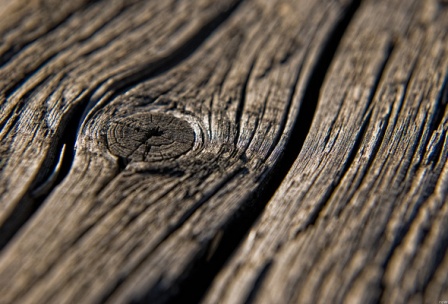
Therefore, you should choose a coating based on climatic and operational characteristics. Different breeds wood has different properties that also need to be taken into account.
Today's assortment amazes the consumer with its diversity and sometimes confuses the inexperienced builder when choosing.
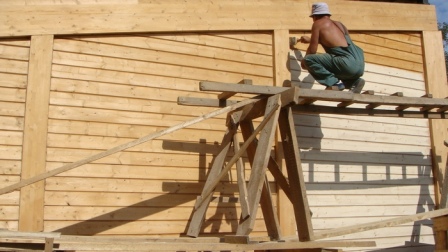
Facade paint and varnish coatings for wood can be classified as follows:
- oil Until recently, they were the most common way to protect wood;
- acrylic. They are becoming increasingly popular due to their not very high price and excellent characteristics;
- silicone. Rarely used due to high price;
- alkyd enamels. Great option for most wooden facades;
- paints for professionals. These are specialized materials that require experience and special technologies for application.
Features of paint and varnish coatings for wood
Oil paints are inexpensive. They are based on drying oil, an environmentally friendly substance. Drying oil is made from a squeeze of hemp, sunflower, and flax oils. This is where the advantages of this coating end.
Among the negative aspects of oil paint, the following can be highlighted:
- a pungent odor that lasts for a long time even after complete drying;
- rapid fading in the sun;
- relatively long drying time (at least 12 hours);
- vapor tightness;
- short service life (up to 3 years);
- impossibility of applying to old paint that has a water-dispersion base.
Acrylic paints are divided into two main types according to their composition: solvent-based and water-based dispersion.
Modern solvent-based acrylics for wood add solvent-soluble resin, weather-resistant additives and ultraviolet filters. Thanks to this composition, this paint does not crack or fade after application, protects well from moisture and allows air to pass through. It protects the surface from negative impact temperature change.
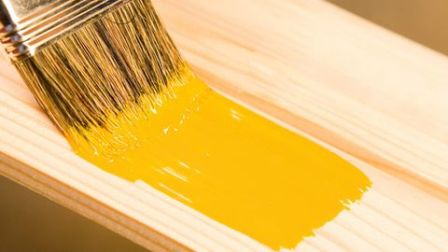
Good to know! Some companies produce solvent-based acrylic paints that can be applied even at sub-zero air temperatures (down to minus 20 Celsius). For example, acrylic-lux.
Facade acrylic paint in aqueous dispersion contains various special additives: polymers, fillers. Some of them add marble chips.
General positive aspects façade acrylic paints for wood are:
- the formation of a protective film, the base of which is plastic;
- high degree of protection from atmospheric and seasonal influences;
- good abrasion resistance;
- creating a breathable surface;
- no odor and quick drying;
- excellent adhesive properties;
- possibility of tinting;
- durability (up to 20 years).
Silicone paint is not widely used due to its high price.
However, it will be very useful in climatic zones with high humidity. The basis of its composition is silicone resins. Distinctive features This paint and varnish material is characterized by increased resistance to moisture, abrasion and excellent crack resistance.
Silicone facade paints are vapor-permeable and are more resistant to elevated temperatures than their acrylic counterparts. This type paints can be applied to pre-painted wooden surfaces regardless of composition old paint. Naturally, it is necessary to use general rules surface preparation.
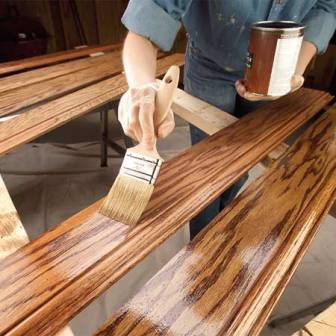
Good to know! Modern facade paints for wood based on silicone resins do not require pre-treatment of the surface with primer and antiseptic.
Alkyd paint for wooden facades basically contains alkyd resins and polyhydric alcohols. This type of paint and varnish material (LPM) forms a protective polymer film on the surface of the wood. Alkyd-based enamels have excellent moisture resistance and heat resistance.
The disadvantage of this type of paint is its relatively short service life (up to 5 years).
Over time, alkyd paint begins to peel and crumble from the surface. To extend the durability of such enamel, you can use a finishing clear varnish.
Due to its composition, alkyd resin paint is a highly hazardous material: it should not come into contact with the eyes and should be kept away from sources of high temperature! The solvent for this coating is white spirit.
Good to know! Alkyd enamel may contain substances that both accelerate drying and slow it down. The longer the drying time of alkyd paint, the more elastic it is.
Types of wood paints rarely used in everyday life
There are wood paints that, due to the complexity of application or high price, are practically not used in household repairs.
One type of such paint is polyurethane enamel. Due to the high cost and complex production technology of 100% polyurethane wood paints, there are not so many on store shelves. They are used more in industrial purposes. The retail cost of polyurethane paint for the average buyer may become too high, even taking into account the increased operating properties and protection of wood.
This paint is usually applied using special equipment that requires specific skills. If you apply this paint at home, you should use a brush or roller. This type of coatings is classified as fire hazardous and toxic materials.
Modern two-component facade paint for wood is also a rarely used protective coating in everyday life. After mixing the components, all paint must be used quickly. This is not always acceptable and not very convenient.
The cost of such pleasure is higher than average, which further reduces the demand of the average buyer.
Wood protection products (video)
Preparing wood for painting
Regardless of the type and its composition, a wooden surface requires preparation before painting.
The preparation process can consist of 2 stages:
- mechanical restoration ;
- protective preparation.
Mechanical treatment may consist of removing the old layer of paint, dirt, dust and sanding the surface. Fresh unpainted facades should also be sanded. This will improve the adhesion of the paint and it will stick better.
Even if paint is applied that does not require removal of the previous layer, care should be taken to remove flaking particles. This also applies to small cracks larger than 1 millimeter, since painting is unlikely to be able to hide them completely.
Good to know! Fresh wood must undergo natural drying before applying paint. The only exception is laminated veneer lumber.
Protective preparation involves priming and coating with antiseptics. The surface must first be cleaned mechanically. For priming, it is best to use a special primer. It greatly improves the adhesive properties of wood and any paint.
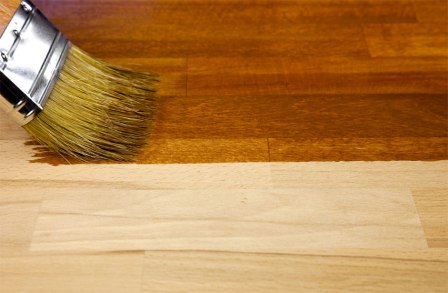
Applying paint to wood
The technology for applying paint to a wooden facade depends on the use of a specific type of paint and varnish.
The general rules for painting wooden surfaces are:
- the tree should be prepared according to the tips above;
- After opening, the paint must be thoroughly mixed;
- when using a spray gun, it is necessary to dilute the paint with a solvent;
- Apply the second layer after the first has completely dried;
- observe safety precautions taking into account the fire and toxic characteristics of the material used for painting; .
- carry out work in dry and warm weather.
To summarize, we can conclude that the most acceptable option for protecting a wooden facade would be water-based acrylic wood paint. To improve its characteristics, the facade should be treated with an antiseptic or impregnation. You can find out: .
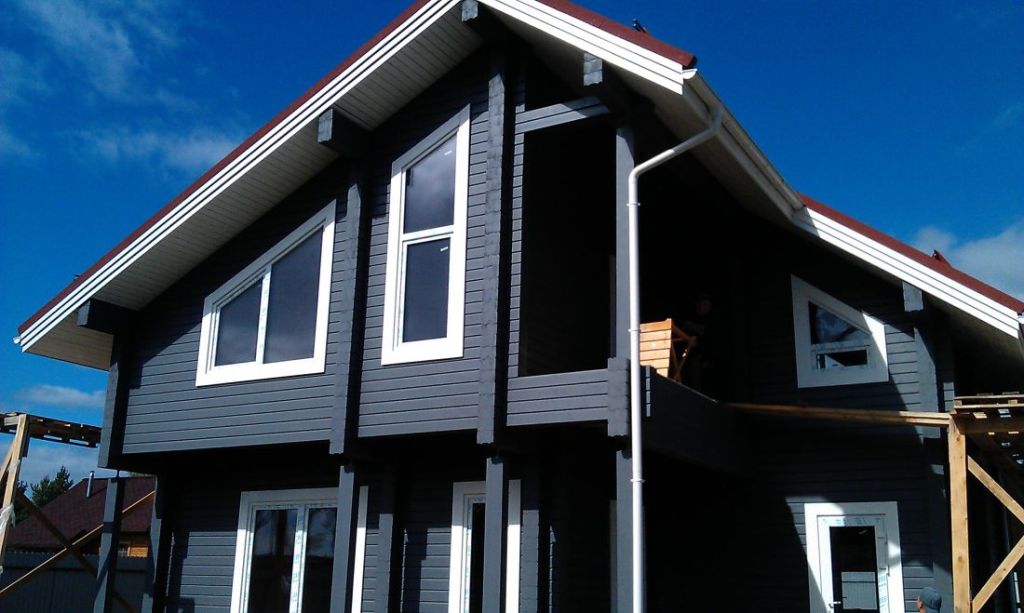
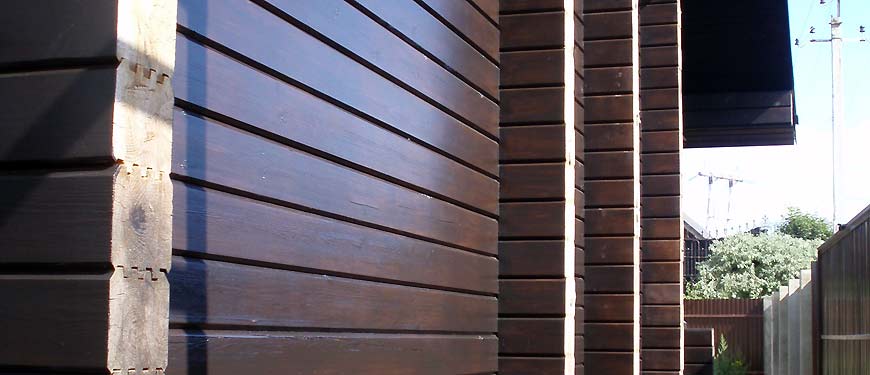
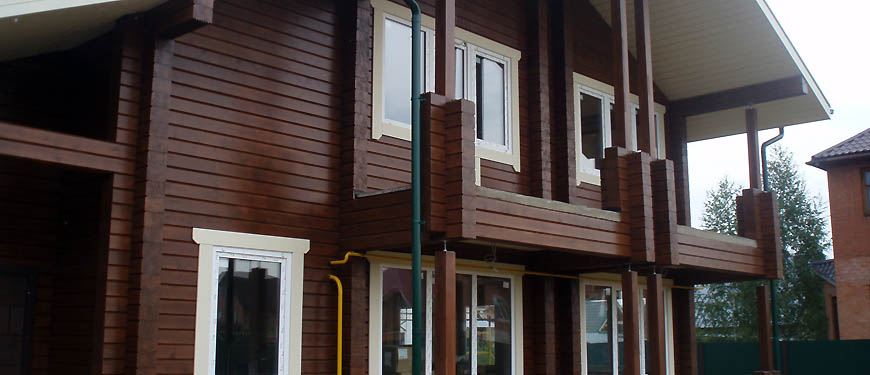
![]()
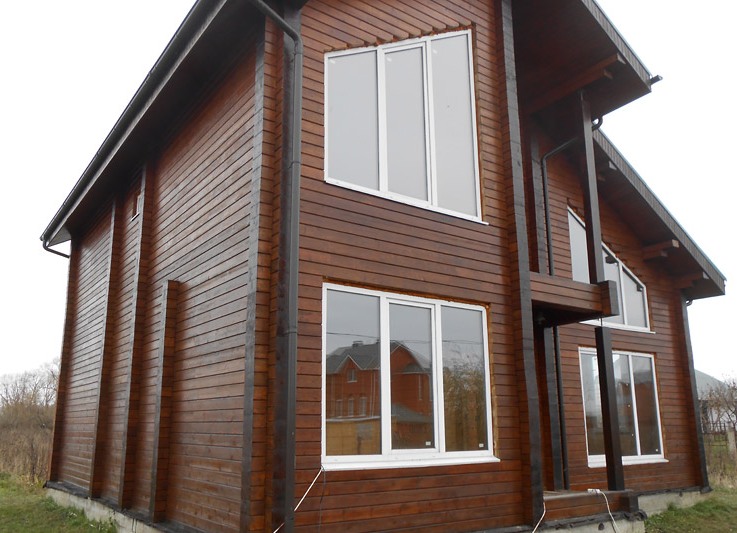
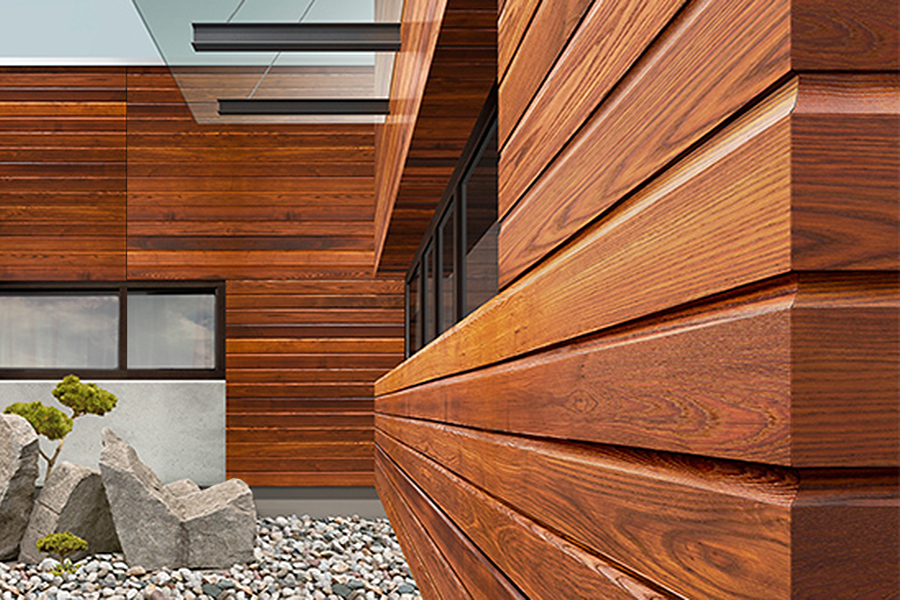
Regardless of the appearance of various materials on the construction market, wooden buildings remain at the peak of popularity. Such houses have a better microclimate, and their construction is sometimes easier than, for example, brick ones. But to maintain an attractive appearance, the tree needs additional processing. Most often, facade wood paint is used for this process. On this moment There are a great variety of such coatings, so it’s worth understanding all the variety presented.
Types of facade paints
The main function of covering a wooden house with paint and varnish material, in addition to the aesthetic component, is to increase the wood’s resistance to external influences and increase its service life. The correct choice of facade paint can perform these two functions simultaneously. So, facade paints on wood intended for exterior work are of the following types:
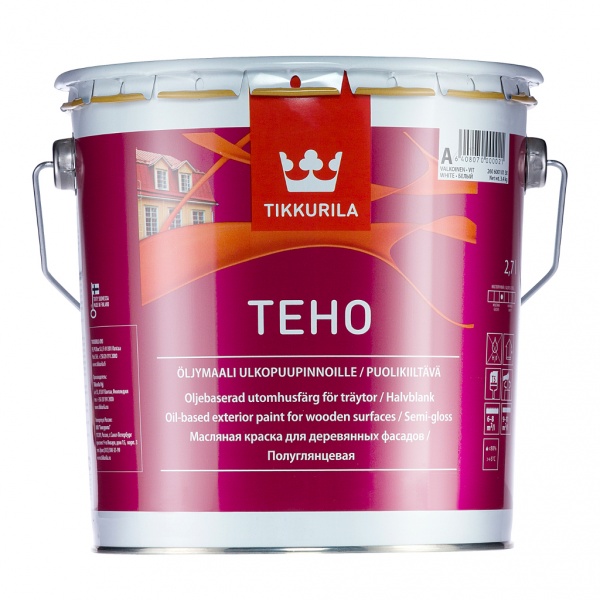
Advantages and disadvantages of facade paints
Each paint has its own positive traits, and negative, so it is worth considering these features depending on the type of solution.
Acrylic is characterized by a high percentage of environmental friendliness and protects the surface much better from the adverse effects of the environment, due to the formation of a kind of film on the surface, from which moisture evaporates when it dries. It became popular thanks to another quality of the resulting layer - strength. Because of this, it does not crack throughout its entire service life, even with strong temperature changes.
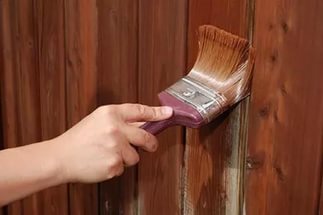
Due to its low cost and wide range of uses, many people choose alkyd paint. It can be used to paint some elements of the house, for example, frames, entrance doors, platbands. It is very important that the surface to be painted is as dry as possible. Otherwise, the resulting layer will very quickly crack and become unusable.
For a long time, until there were other types, oil paints were very popular. At the moment, facades are painted with them less and less, since such a solution has poor adhesion to other painting materials. If the surface is covered oil paint, then it will no longer be possible to update it with another paint and varnish substance. In addition, it takes a long time to dry and has a very pungent and unpleasant odor.
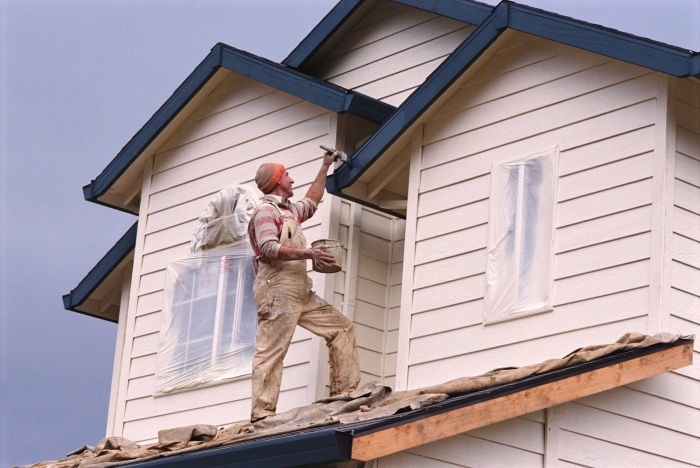
Criteria for choosing paint for the facade
For a wooden facade, you should select a composition that is not afraid of exposure to moisture, temperature changes and direct sun rays. The surface must be vapor-permeable so that the house has the opportunity to “breathe”. In any case, facade paint for wood should have high degree adhesion not only to wood, but also to other paints and varnishes. An additional advantage will protect the wood from fungus and mold.
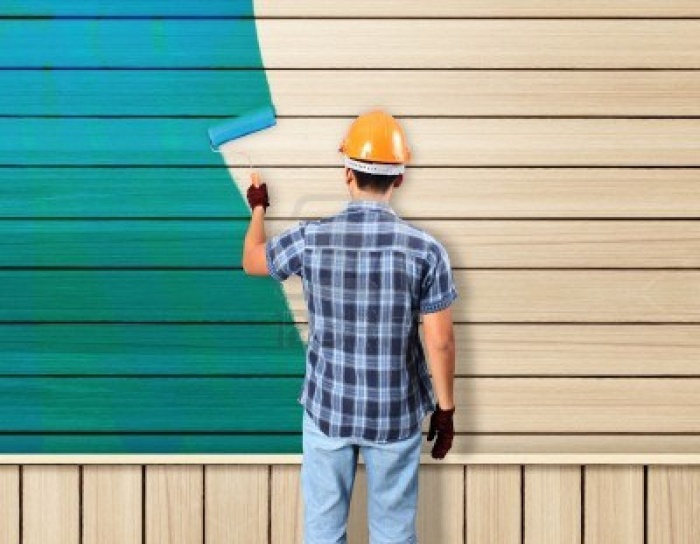
Most often, acrylic compounds are chosen for wooden facades, which will retain their properties throughout the entire period of operation. At the moment, this paint and varnish material is presented in a large assortment on the construction market. When choosing, you should decide on the necessary paint properties and shade. It would also be useful to clarify the service life and compare it with the one that is planned. It is imperative to find out in advance whether the paint can be applied to an already painted surface and hide minor defects. Fire retardant wood paint is often chosen for wood buildings.
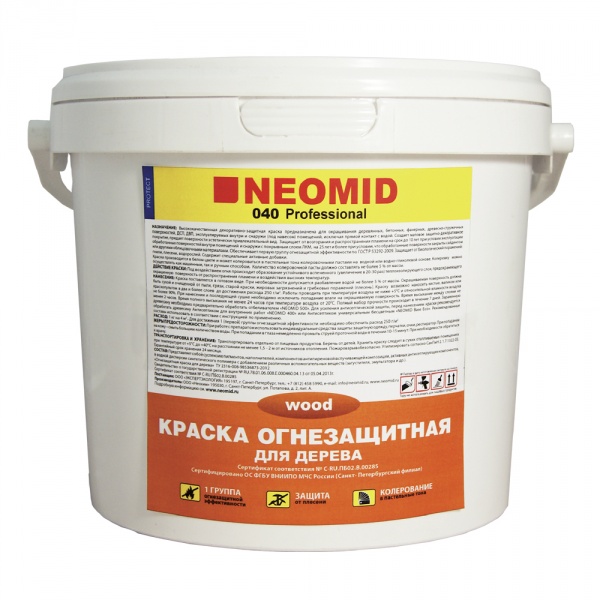
Popular manufacturers and prices
At the moment, as mentioned, there are many types of facade compositions made of wood from a wide variety of manufacturers on the market. Here are the most popular ones:
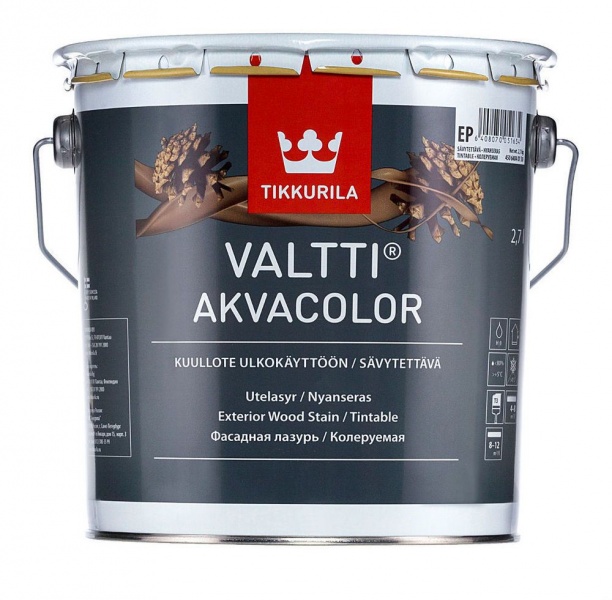
We also cannot fail to mention Soppka fire-retardant paint Russian production. This composition protects the wood not only from the spread of fire, but also from the effects of fungus and mold, acting as an antiseptic.
We can cite as an example the domestic paint Olympus, which is made on the basis linseed oil, which further strengthens the wood surface. This paint is alkyd and combines high quality and affordable price.
Application of façade paint
In order for the finished layer to serve long time, it must be applied correctly. In this process, the following rules should be followed:
- Preliminary cleaning of the surface from the old coating and complete drying.
- Mandatory mixing of paint before application.
- Application is carried out in several layers. How many there will be depends on the type of paint product and surface.
- If the paint is thick, it is diluted with a solvent.
- The paint must be given the necessary time to dry. As a rule, 1 layer on the surface dries within 4 hours.
- Painting work can be carried out at temperatures ranging from -10 to +55 degrees Celsius.
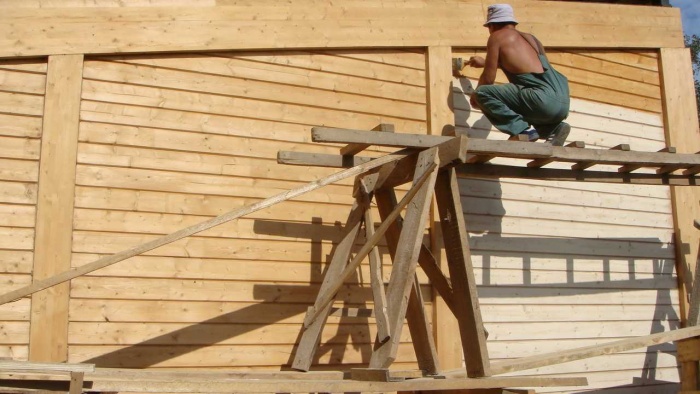
Technology of painting with water-based and acrylic paints
First you need to carefully prepare the surface for application. To do this, remove the old layer and remove excess dust and dirt from the surface with a stiff brush. A special cleaning solution is used to remove mold and moss. If there are visible defects on the surface, they are treated with a grinding machine or sandpaper.
Advice! It is best to treat the surface with a primer with an antiseptic effect.
![]()
After preparation, wood paint for exterior use is diluted with a solvent as needed and applied to the surface. Drying time for one layer is from 2 to 4 hours. If the paint is not finished, it is prohibited to store it at sub-zero temperatures, so it is better to take the solution into the house or garage.
Application of alkyd paint
This type of coloring agent should also be applied to a prepared and completely cleaned surface. The wood must be coated with a primer. As previously mentioned, this paint is applied only to a dry surface to avoid cracking.
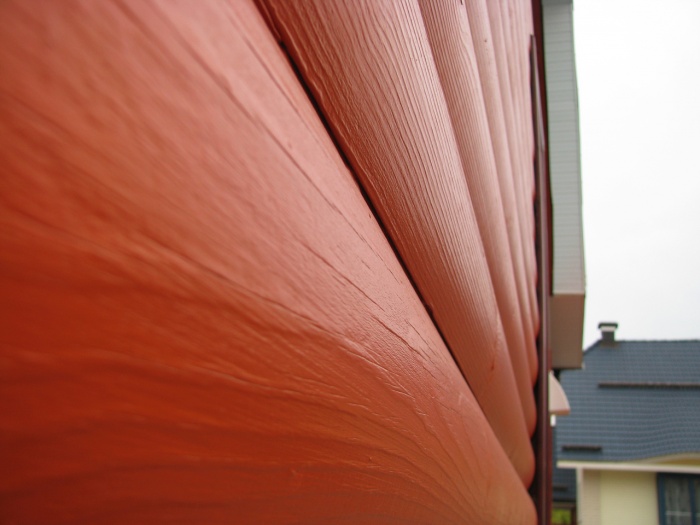
Applying oil paint
At the first stage, it is also worth preparing the surface in advance. The paint is diluted to the desired consistency with drying oil. It is very convenient that this type of paint can be applied at low negative ambient temperatures. Complete drying of the oil layer of paint occurs in at least 24 hours.
Important! To increase the service life of the finished layer, you can apply a layer of oil varnish to it.
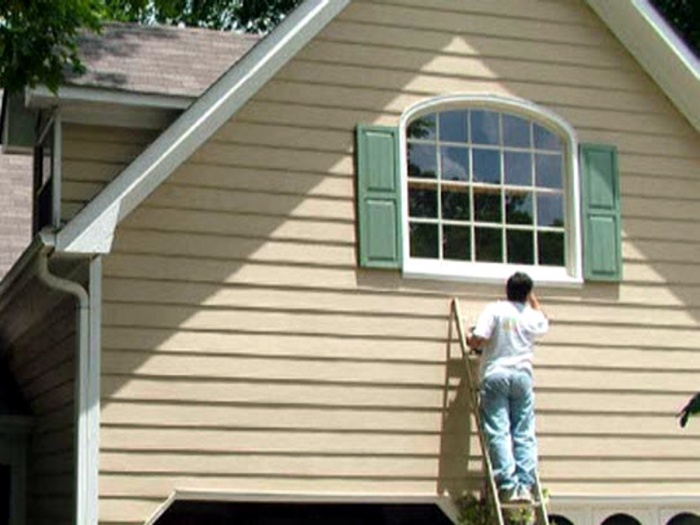
Unused paint should only be stored in a tightly closed container in a dry and dark place.
Conclusion
Now you can choose the most suitable type facade paint for wooden surfaces. Each of them has its own characteristics and nuances, which you should find out about in advance before purchasing in order to make right choice in favor of one solution or another. Using this article, you can weigh the pros and cons and decide on the paint manufacturer.
As is known, the facade is main part home, and the impression about the building itself, and about its owner, is formed precisely after the first glance at the front part of the building.
But it must have a good finish not only because it “ business card" Of course, cladding also has a practical meaning. It protects the facade from precipitation, sunlight and damage by insects and bacteria.
Destructive factors
Due to the impact of all of the above negative factors, the facades of buildings are destroyed. Moreover, this applies not only to buildings built a long time ago and standing without repair for decades. Even the facade of a relatively young wooden building can be subject to this kind damage if low-quality paint for wooden facades was used when painting it.
The front part of the house constantly resists negative natural factors.
In good weather it is ultraviolet light and humidity. In other cases, wind, rain and snow. Therefore, to properly protect the facade, high-quality façade paints for wood should be used.
Paint for the facade of a wooden house must be chosen taking into account climatic features region where the building is located. Temperature difference - common occurrence in our latitudes, and this also needs to be taken into account when choosing facade paints for wood.
If the material that was used in the decoration of the building does not have good resistance to weathering, the destruction of the facade will occur faster. Large chips may occur along the front of the house. Therefore, it is recommended to use the best façade wood paints for painting. The façade of a wooden house must also be painted correctly; the photo on the website demonstrates this process.
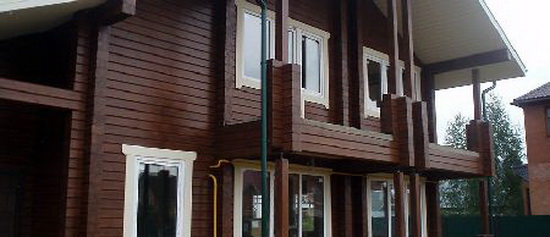
Main types of paint
In the decoration of wooden houses, different facade paints for wood are used. The main ones are:
- acrylic;
- polyvinyl acetate;
- butadiene-styrene
Polyvinyl acetate (PVA) paint for wooden facades is used extremely rarely.
Although their cost is low, people are in no hurry to buy such façade paints for wood, since they withstand high humidity very poorly.
This paint for the facade of a wooden house improves its performance properties if polymers are added to it, due to which the durability of the paint becomes longer. However, acrylic facade paints for wood are always more durable.
Wooden houses are also rarely used. In general, styrene butadiene provides good moisture resistance. However, paint for the facade of a wooden house, which includes this component, is used very rarely because it does not withstand ultraviolet radiation well. So butadiene-based paint is used, as a rule, only during interior work.
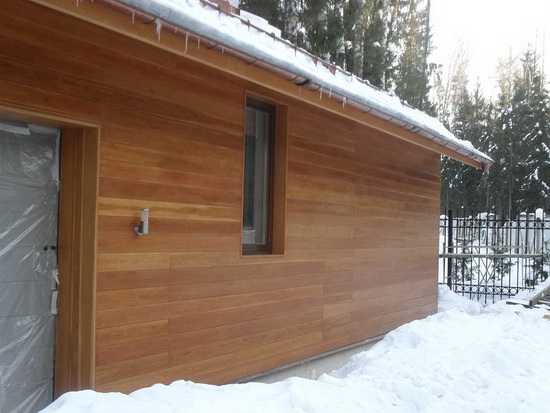
Painting wooden facades
It is difficult for an inexperienced person to make the right choice of one paint or another for painting a wooden facade. Therefore, it is recommended that you familiarize yourself with information about various compositions in advance.
Of course, the sales consultant will always tell you what is best to buy for such and such an occasion. But knowing all the nuances will certainly protect you from making the wrong choice.
The colors differ, first of all, chemical composition. In particular, it is important which solvent the composition includes. Thus, to determine which paint is most suitable, you need to clearly understand what kind of surface will be painted with it and how the climatic conditions of a given area can affect the protective layer of the facade. Once all these conditions are clarified, you have a much smaller number of options to choose from, which saves you time.
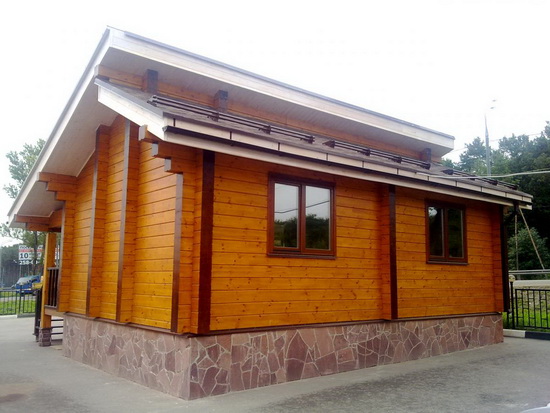
Most often, the manufacturer warns that such and such paint cannot be used to coat a particular material or for exterior work, for example, information about this is on the paint packaging. It is also necessary to ensure that the chosen paint is intended specifically for painting facades.
Even when choosing paint and varnish products, you should think about which composition is most suitable for. After all, the paint can be transparent, glossy, satin, matte or semi-matte, etc.
It is also important what kind of coloring will be done. Will this be done for the first time or the facade has already been painted previously with one or another paint composition.
It is also important how much paint you need to use and whether there are any special features in its use. As a rule, all this is indicated on the packaging.
When purchasing paint, ask for a certificate confirming its quality.
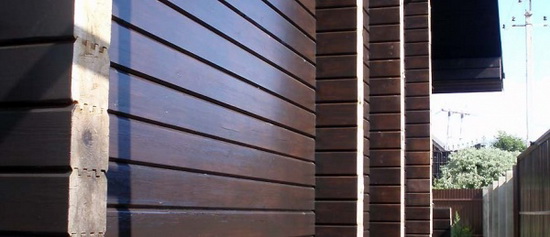
Proper insulation of the walls outside of a brick house “in years” will make your home much more durable and will eliminate excess moisture, which could cause mold....
Although in the famous hit from the popular Soviet film “ Love affair at work"and it is stated that nature does not have bad weather, and every weather is grace, this is in no way...
First of all, when choosing facade paint, you need to understand which surface is to be painted with it. More often, manufacturers offer colorless and white facade paints. They are also called...




